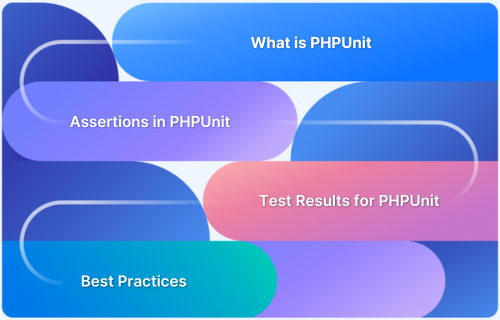Unit testing is a critical component of modern software development. It ensures that individual units or components of an application perform as intended. Unit testing is critical in PHP development because of the frequent use of dynamic and fast-changing codebases.
Overview
What is PHPUnit?
PHPUnit is a popular testing framework for PHP, designed to support unit testing and test-driven development (TDD). It allows developers to write and execute tests to ensure code behaves as expected and helps maintain high-quality, bug-free applications.
Features of PHPUnit
- Test Automation: Automates repetitive testing tasks with minimal effort.
- Mocking Framework: Supports creating mock objects for isolated testing.
- Assertions: Built-in methods to validate expected outcomes.
- Code Coverage Analysis: Tracks the percentage of code executed during tests.
- Test Suites: Organize and run related test cases together.
- Integration: Works seamlessly with CI/CD tools and IDEs.
Assertions in PHPUnit
- assertEquals(): Checks if two values are equal.
- assertTrue() / assertFalse(): Validates boolean conditions.
- assertNull(): Ensures a variable is null.
- assertContains(): Verifies if an element exists in an array or string.
- assertInstanceOf(): Confirms an object is of a specific class.
- assertCount(): Validates the number of items in an array or iterable.
This guide explains PHPUnit, its features, creating a basic test case in PHPUnit, Assertions, and more.
What is Unit Testing in PHP?
Unit testing in PHP is the practice of verifying that individual components of an application, such as functions or methods, perform as intended when isolated from the rest of the system. By focusing on the smallest units of code, developers can identify and fix issues early in the development process, leading to more stable and reliable applications.
It ensures that each piece of code behaves correctly under various conditions, including edge cases and invalid inputs. This improves code quality and makes refactoring safer, as any broken functionality can be detected immediately.
Unit testing promotes modular programming, encouraging developers to write clean and maintainable code. With tools like PHPUnit, creating and running tests becomes a structured process, offering detailed feedback on test results. The automation provided by such tools reduces the reliance on manual testing, speeding up development and deployment.
Benefits of Unit Testing in PHP Development
Unit testing offers advantages for PHP developers. It helps create more reliable and maintainable applications by proactively ensuring that each individual unit of code behaves as intended before being integrated into larger systems.
- Early Bug Detection: Unit tests allow developers to identify and fix bugs during the development phase long before they can impact the final application or end users.
- Confidence in Code Changes: When modifying or refactoring code, unit tests provide assurance that existing functionality remains unaffected, enabling developers to innovate without fear of breaking the application.
- Improved Code Quality: Writing unit tests encourages a modular and clean code structure. Developers tend to write smaller, self-contained functions that are easier to test and maintain.
- Enhanced Collaboration: Unit tests act as a safety net in team environments, ensuring that changes made by one developer do not negatively impact the work of others.
- Live Documentation: Test cases describe how the code should behave in various scenarios, serving as a form of live documentation for developers and stakeholders.
- Simplified Debugging: When a test fails, it pinpoints the exact function or method causing the issue, making it easier and faster to debug problems.
Common Unit Testing Tools for PHP
PHP developers have access to a variety of tools that make unit testing efficient and manageable. Each tool comes with its own set of features, catering to different testing needs and development styles.
Common Unit Testing Tools for PHP:
- PHPUnit
- Codeception
- Pest
- PHPSpec
- Mockery
- Behat
- Atoum
- SimpleTest
Here’s a detailed explanation of each tool.
1. PHPUnit
PHPUnit is the gold standard for PHP unit testing, offering a comprehensive suite of features that cater to both novice and experienced developers.
Key Features:
- Robust assertions and test doubles (mocks, stubs, fakes).
- Integration with CI/CD pipelines for seamless automation.
- Detailed test result reports.
- Supports testing for legacy and modern PHP codebases.
Pros:
- Widely adopted with extensive documentation and community support.
- Highly customizable and extendable.
- Great for testing both small and large-scale applications.
Cons:
- Steeper learning curve for beginners compared to simpler frameworks.
2. Codeception
Codeception is a versatile framework supporting unit, functional, and acceptance testing. It’s ideal for developers working on diverse testing needs, including Behavior-Driven Development (BDD).
Key Features:
- Unified framework for various test types.
- Supports BDD with human-readable test scenarios.
- Easily integrates with Selenium, REST APIs, and more.
Pros:
- Simplifies complex testing workflows.
- Suitable for teams with mixed technical expertise.
- Active community and frequent updates.
Cons:
- Can feel overwhelming for projects requiring only basic unit testing.
Read More: Top 15 Unit Testing Tools
3. Pest
Pest is a modern, lightweight testing framework designed for simplicity and developer happiness. It emphasizes an expressive syntax and reduced boilerplate.
Key Features:
- Minimalistic syntax that’s easy to read and write.
- Fully compatible with PHPUnit, allowing gradual adoption.
- Extensions for additional functionality.
Pros:
- Beginner-friendly and enjoyable to use.
- Encourages clean, concise tests.
- Fast-growing community
Cons:
- Limited advanced features compared to PHPUnit.
4. PHPSpec
PHPSpec is built for Behavior-Driven Development (BDD), helping developers focus on defining how the code should behave rather than its implementation.
Key Features:
- Encourages a test-first development approach.
- Focused on describing specifications for code behavior.
- Promotes cleaner, more maintainable code.
Pros:
- Ideal for designing code with clear business requirements.
- Encourages best practices in software design.
Cons:
- Limited to BDD-style testing; not ideal for other test types.
Read More: Top 15 Unit Testing Frameworks
5. Mockery
Mockery is a dedicated mocking library that works alongside frameworks like PHPUnit to create test doubles for simulating real-world scenarios.
Key Features:
- Intuitive API for creating mocks and stubs.
- Supports complex object behavior simulation.
- Compatible with other PHP testing frameworks.
Pros:
- Simplifies testing of complex object dependencies.
- Reduces test complexity.
Cons:
- Requires a good understanding of mocking concepts.
6. Behat
Behat is another BDD tool, focusing on acceptance testing and ensuring applications meet business requirements. It’s particularly useful for collaboration between developers and non-technical stakeholders.
Key Features:
- Gherkin syntax for writing tests in plain language.
- Supports collaboration with business teams.
- Extensive integrations with testing tools.
Pros:
- Makes tests accessible to non-developers.
- Ideal for acceptance and functional testing
Cons:
- Limited scope for unit testing.
Read More: TDD vs BDD vd ATDD: Key Differences
7. Atoum
Atoum is a lightweight and fast unit testing framework, perfect for developers seeking simplicity and speed.
Key Features:
- Minimalistic design for quick test execution.
- Built-in mocking and code coverage analysis.
Pros:
- Easy to set up and use.
- Faster test execution than heavier frameworks
Cons:
- Less feature-rich compared to PHPUnit or Codeception.
Read More: Code Coverage Techniques and Tools
8. SimpleTest
SimpleTest is an older PHP testing framework that still finds its place in maintaining legacy PHP projects.
Key Features:
- Supports both unit and web testing.
- Lightweight and easy to configure.
Pros:
- Straightforward for simple testing needs.
- Great for legacy projects.
Cons:
- Lacks modern features and updates.
Read More: Performing NodeJS Unit testing using Jest
What is PHPUnit for PHP Testing?
PHPUnit is the most popular framework for unit testing in PHP. It provides developers with the tools they need to ensure that individual components of their application, such as functions and methods, behave as expected. It supports Test-Driven Development (TDD).
PHPUnit follows the xUnit architecture, which is a standard for unit testing frameworks, making it familiar to developers who have worked with testing tools in other programming languages like JUnit for Java or NUnit for .NET.
Key Features of PHPUnit:
- xUnit-Based Architecture: Built on the standardized xUnit framework, making it intuitive for developers familiar with other unit testing tools like JUnit or NUnit.
- Rich Assertions: Provides a variety of assertions to test different conditions, such as equality, truth, exceptions, and array contents.
- Test Suites: Organize and run groups of related test cases for better structure and manageability.
- Test Doubles Support: Offers mocks, stubs, and fakes for simulating objects and dependencies during tests.
- Code Coverage Analysis: Identifies parts of the code that are tested and highlights untested areas.
- Integration Ready: Works seamlessly with CI/CD tools like Jenkins, GitHub Actions, and GitLab CI.
Read More: NUnit vs XUnit vs MSTest: Core Differences
Creating a Basic Test Case with PHPUnit
A test case is a single scenario designed to validate a specific functionality of your application. For example, if you’re testing a calculator’s add method, the test case would ensure that the method returns the correct sum for given inputs.
Each test case is a method within a test class that uses PHPUnit’s features to validate expected behavior.
Steps to Create a Basic Test Case
- Step 1. Set Up PHPUnit: PHPUnit must be installed and configured in your project. This is usually done via Composer
composer require --dev phpunit/phpunit
PHPUnit’s configuration file (phpunit.xml or phpunit.xml.dist) can also be added to define settings like test directories and environment variables.
- Step 2. Create the Class to Test: Before writing tests, you need the class or function you want to test.
<?php
class Calculator
{
public function add($a, $b)
{
return $a + $b;
}
public function subtract($a, $b)
{
return $a - $b;
}
}This simple Calculator class has two methods: add and subtract.
- Step 3. Create a Test Class: In PHPUnit, test classes must extend PHPUnit\Framework\TestCase. This allows the test class to use PHPUnit’s testing methods and assertions.
<?php
use PHPUnit\Framework\TestCase;
class CalculatorTest extends TestCase
{
// Test methods go here
}- Step 4. Write Test Methods: Test methods should validate specific behaviors of the class. For instance, to test the add method.
public function testAddition()
{
$calculator = new Calculator();
$result = $calculator->add(2, 3);
$this->assertEquals(5, $result, "Addition did not return the expected result.");
}Complete Example :
<?php
require_once 'Calculator.php';
use PHPUnit\Framework\TestCase;
class CalculatorTest extends TestCase
{
public function testAddition()
{
$calculator = new Calculator();
$result = $calculator->add(2, 3);
$this->assertEquals(5, $result);
}
public function testSubtraction()
{
$calculator = new Calculator();
$result = $calculator->subtract(5, 3);
$this->assertEquals(2, $result);
}
}Read More: Understanding Unit Tetsing in Python
Understanding Assertions in PHPUnit
An assertion is a statement in your test case that checks a condition. It compares actual outcomes (from your code) against expected outcomes (defined in your test) to verify correctness.
Assertions are critical because they determine whether a test passes or fails.
PHPUnit provides many assertions to test different conditions.
Below are some commonly used assertions:
- assertEquals($expected, $actual, $message) : Checks if two values are equal.
$this->assertEquals(10, $result, "The result is not equal to 10.");
- assertNotEquals($expected, $actual, $message) : Ensures that two values are not equal.
$this->assertNotEquals(0, $result, "The result should not be 0.");
- assertTrue($condition, $message): Verifies that a condition is true.
$this->assertTrue(is_array($result), "The result is not an array.");
- assertFalse($condition, $message): Verifies that a condition is false.
$this->assertFalse(empty($result), "The result is unexpectedly empty.");
- assertNull($value, $message): Ensures a value is null.
$this->assertNull($result, "The result is not null.");
- assertNotNull($value, $message): Ensures a value is not null.
$this->assertNotNull($user, "User object should not be null.");
- assertContains($needle, $haystack, $message): Checks if a value exists within a given array or string.
$this->assertContains(5, $array, "The array does not contain the expected value.");
- assertCount($expectedCount, $array, $message): Verifies the number of elements in an array or Countable object.
$this->assertCount(3, $items, "The array does not have 3 elements.");
- assertInstanceOf($expectedClass, $object, $message): Ensures that an object is an instance of a specific class.
$this->assertInstanceOf(User::class, $user, "The object is not an instance of the User class.");
- assertSame($expected, $actual, $message): Verifies that two values are identical (same type and value).
$this->assertSame('5', $result, "The result is not exactly the same as '5'.");Read More: Understanding JUnit Assertions with Examples
Running and Interpreting Test Results for PHP Unit Testing
Once you’ve written your PHPUnit tests, the next step is to run them and interpret the results to ensure your code works as expected. PHPUnit provides a command-line interface to execute tests and offers detailed feedback on the outcomes.
How to Run PHPUnit Tests
Step 1. Navigate to Your Project Directory: Open a terminal or command prompt and move to the root directory of your PHP project where PHPUnit is installed.
Step 2. Run All Tests: Use the following command to run all tests in the default tests directory.\
vendor/bin/phpunit
PHPUnit will automatically detect and execute all test classes and methods in the specified directory.
Step 3. Run a Specific Test File: To test a specific file, provide its path:
vendor/bin/phpunit tests/CalculatorTest.php
Interpreting Results
Step 1. All Tests Pass: If all tests pass, congratulations! Your code behaves as expected under the tested conditions.
OK (3 tests, 5 assertions)
Step 2. A Test Fails: A failed test means there’s a mismatch between the actual output of your code and the expected result. Carefully read the failure message and locate the problem in your code.
1) CalculatorTest::testAddition Failed asserting that 4 matches expected 5. /path/to/tests/CalculatorTest.php:15
Step 3. Errors: Errors often indicate that something is broken in your test or code. For instance, you might be testing a method that doesn’t exist or referencing a missing class.
1) CalculatorTest::testDivision Error: Call to undefined method Calculator::divide()
Step 4. Skipped Tests: Tests can be skipped intentionally when a prerequisite is not met. For example, if a test requires a database connection and it’s unavailable.
OK, but incomplete, skipped, or risky tests! Tests: 3, Assertions: 5, Skipped: 1.
Best Practices for Unit Testing in PHP
Unit testing is a critical part of maintaining high-quality PHP code. Following best practices ensures your tests are effective, readable, and maintainable.
Below is a breakdown of the best practices into actionable guidelines under specific areas.
Structuring Test Cases and Test Methods
- Follow Naming Conventions: Use descriptive names for test cases and methods to make them self-explanatory.
- Example: A method named testUserCanLogInWithValidCredentials immediately conveys its purpose.
- Use One Assertion Per Test: Each test should verify a single behavior or condition. This simplifies debugging when a test fails.
- Group-Related Tests in Classes: Organize test methods logically within a test class. For instance, a UserTest class can include methods like testUserCreation and testUserDeletion.
- Set Up and Tear Down Properly: Use setUp() and tearDown() methods to initialize and clean up resources required by tests.
protected function setUp(): void {
$this->user = new User();
}- Use Data Providers: For repetitive tests with different inputs, use PHPUnit’s @dataProvider to pass multiple datasets to a single test method.
/**
* @dataProvider additionProvider
*/
public function testAddition($a, $b, $expected) {
$this->assertEquals($expected, $a + $b);
}Read More: Best Practices for Unit Testing
Writing Readable and Maintainable Tests
- Keep Tests Focused: Each test should validate one aspect of a feature. Avoid combining unrelated checks in a single test.
- Write Clear Assertions: Use meaningful messages in assertions to describe what went wrong if the test fails.
- Avoid Hardcoding Values: Use constants or variables for values used across multiple tests. This makes updates easier.
- Comment Complex Tests: Add comments to explain the purpose of a test or why certain steps are necessary, especially for non-obvious logic.
- Follow DRY Principles: Reuse common setup or helper methods to reduce duplication.
- Use Readable Formatting: Organize your code with proper spacing and alignment to enhance readability.
Bad Example:
public function testAddition(){$this->assertEquals(5,3+2);}Good Example:
public function testAddition() {
$this->assertEquals(5, 3 + 2);
}Using Test Doubles (Mocks, Stubs, and Fakes)
Test doubles simulate the behavior of real objects, making it easier to isolate the unit under test. PHPUnit provides built-in support for creating these test doubles.
- Mocks: Use mocks to test the interaction between objects, verifying that specific methods are called with expected arguments.
$mock = $this->createMock(Database::class);
$mock->expects($this->once())
->method('save')
->with($this->equalTo($data));- Stubs: Use stubs to return predefined values from methods during a test.
$stub = $this->createStub(UserRepository::class);
$stub->method('findUserById')
->willReturn(new User('John Doe'));- Fakes: Use fakes to simulate a simpler version of an actual component, such as an in-memory database. Fakes are useful for testing without external dependencies.
When to Use Test Doubles:
- The real object is too slow (for example, a database).
- The real object involves external APIs.
- The real object has unpredictable behavior (for example, random data or system time).
Why Automate PHP Tests?
Automating PHP tests is essential for improving development efficiency and ensuring code reliability. Unlike manual testing, which is time-consuming and prone to human error, automated tests can be executed quickly and repeatedly, saving time while ensuring consistent results.
With automation, developers can run tests after every code change, catching bugs early in the development process and reducing the risk of regressions. This leads to faster development cycles and more stable applications.
BrowserStack Automate allows developers to run automated PHPUnit tests on a vast cloud of real devices and browsers. This ensures your application works seamlessly across multiple environments without needing to set up a local testing infrastructure.
BrowserStack’s real-device testing eliminates the guesswork involved in emulating environments, giving you accurate results and greater confidence in your code.
By automating your PHP tests with tools like BrowserStack Automate, you enhance productivity, improve code quality, and deliver robust, cross-platform applications faster and more efficiently.
Refer to this documentation, for more details on how to write a sample test case in PHPUnit and then integrate it with BrowserStack.
Why run PHP Tests on Real Devices?
Running PHP tests on real devices is critical to ensure your application performs flawlessly in real-world scenarios. While emulators and simulators provide a convenient way to test, they often fail to capture the nuances of actual device environments.
Factors like hardware performance, unique browser behaviors, or specific OS-level interactions can only be accurately evaluated on real devices. Ignoring these differences can lead to undetected bugs that only surface when users interact with your application.
Testing on real devices ensures you deliver a consistent and reliable user experience across various device types, screen resolutions, and operating systems.
For instance, what works seamlessly on a high-end desktop browser might behave differently on an older smartphone or tablet. Real-device testing helps identify and fix these discrepancies early.
Choose testing platforms like BrowserStack Automate that provides a Real Device Cloud with access to 3500+ real devices and browsers directly from the cloud. You can automate your PHP tests across these environments without investing in physical devices or maintaining a costly in-house lab.
By running tests on real devices through BrowserStack, you ensure your application meets the expectations of all users, regardless of their device or platform, improving reliability and user satisfaction.
How to Run PHP Tests on BrowserStack?
Running PHP tests on BrowserStack is a straightforward process that allows you to test your application across a wide range of real devices and browsers.
Step 1: Set Up BrowserStack Credentials
- Sign up for a BrowserStack account if you don’t already have one.
- Once logged in, navigate to your Automate Dashboard to retrieve your Access Key and Username. These credentials will authenticate your tests with BrowserStack.
Step 2: Install Required Libraries
- Ensure you have Selenium WebDriver installed in your project. Use the following command if it’s not already installed:
composer require php-webdriver/webdriver
- Integrate BrowserStack’s PHP bindings by adding the required configurations to your project.
Read More: Architecture of Selenium WebDriver
Step 3: Write Your Test Script
- Create a PHP file (for example, browserstack_test.php) and set up your Selenium test with BrowserStack capabilities:
<?php
require 'vendor/autoload.php';
use Facebook\WebDriver\Remote\RemoteWebDriver;
use Facebook\WebDriver\Remote\DesiredCapabilities;
$BROWSERSTACK_USERNAME = "your_username";
$BROWSERSTACK_ACCESS_KEY = "your_access_key";
$serverUrl = "https://$BROWSERSTACK_USERNAME:$BROWSERSTACK_ACCESS_KEY@hub-cloud.browserstack.com/wd/hub";
$caps = DesiredCapabilities::chrome();
$caps->setCapability("browserstack.debug", true);
$caps->setCapability("os", "Windows");
$caps->setCapability("os_version", "10");
$caps->setCapability("browser", "Chrome");
$caps->setCapability("browser_version", "latest");
$driver = RemoteWebDriver::create($serverUrl, $caps);
$driver->get("https://www.example.com");
echo $driver->getTitle();
$driver->quit();
?>- Replace “your_username” and “your_access_key” with your BrowserStack credentials. Modify the DesiredCapabilities to test on your preferred browser and OS combination.
Step 4: Run the Test
- Execute your test script using the PHP command
composer require php-webdriver/webdriver
- BrowserStack will launch the specified browser and run the test on a real device or virtual environment in the cloud
Conclusion
PHPUnit is a powerful testing framework for PHP, designed to help developers write unit tests to ensure their code works as expected. By using PHPUnit, you can catch bugs early, verify that your functions behave correctly, and maintain higher code quality throughout the development process.
This article covered getting started with PHPUnit, such as installation and setting up a test project, to writing test cases and understanding advanced topics like assertions, data providers, and test doubles like mocks and stubs.
Using PHPUnit in your workflow makes debugging easier and gives you confidence when making changes to your code. It ensures your application remains stable even as it evolves.
Run automated PHPUnit tests on real devices and browsers with BrowserStack Automate. Ensure cross-platform compatibility, boost productivity, and deliver robust applications faster.





